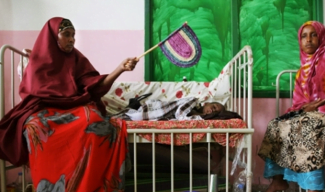Ed note. This item is cross posted from our friends at The Interdependent
On December 13, the United Nations Mission in Somalia asked donors for $1.5 billion to support the world’s largest humanitarian mission for the coming year. Despite a massive influx of aid in 2011, as the UN declared famine in the country for the first time in nearly 20 years, some 250,000 Somalis are still at risk of imminent death, and another four million remain in danger. In 2012, The UN expects the crisis to get worse before it gets better.
The price of helping Somalia is high—the highest in the world, says the resident UN coordinator for Somalia, Mark Bowden. But it’s hard to imagine how it wouldn’t be: By almost every measure, this country is not just the neediest, but also the most complicated operating environment for aid anywhere on Earth. An Islamist insurgency controls much of the south of the country, pockets of the country remain embroiled in active military conflict, whole swathes are cut off from aid, infrastructure is crumbling and the rainy season is clogging roads, and what economy remains in the war-torn country is predicated on the conflict being sustained.

Somalia’s Consolidated Appeal (CAP) comes at a time when all these elements are as present as ever. “The $1.5 billion appeal,” says Bowden, “is based on a realistic assessment of what is required to sustain the response to the world’s largest humanitarian crisis.”
It’s worth having a look back at the evolution of that aid operation since it began in force last year. At the beginning of 2011, 2.4 million Somalis were in need of aid. Within months, that number had almost doubled to four million. The world responded to Somalia’s visible troubles—but aid came in slowly and far too late to avert the worst crisis. By August of last year, nearly a quarter of those people were in danger of imminent death if they didn’t receive humanitarian assistance. Throughout the fall, those numbers have fallen, but aid workers caution it would be easy for the positive trend to reverse. This year, the UN hopes that funding will come earlier and more often.
But in fact, it has never been as easy as getting the money to the right place. Somalia’s famine has been—perhaps even more than most—political. As 2012 begins, the greatest risks to the country’s population are once again more about men than money. Islamist insurgent group al-Shabaab continues to thwart humanitarian access, military operations continue to displace the population, and a transitional government mired in internal conflict struggles to provide services at all.
At the height of the crisis last year, al-Shabaab loosened some of its earlier bans on humanitarian aid; it reopened parts of the south to UN agencies and abandoned its positions in the capital of Mogadishu, allowing African Union peacekeepers to consolidate their hold on the city. In late November, however, some of those gains were reversed. The rebels issued a press release barring a number of UN agencies—nearly all except the Food and Agriculture Organization—from operating on their turf. Even in Mogadishu, where the rebels are no longer present, they continue to create insecurity through a suicide bombing campaign that has limited aid workers’ mobility and kept expat staff at the bare minimum.
Military operations against al-Shabaab—although perhaps helpful in the medium term—have had consequences as well. In October, Kenyan forces entered Southern Somalia to chase the militants back from the border. Despite their proclaimed intention to help, the UN says that civilians are fleeing the combat zones.
Piled on top of this general insecurity is a war economy that has at times profited from the aid flowing in. In its June report to the UN Security Council, the UN Expert Monitoring Group on Somalia and Eritrea noted incidences of al-Shabaab raiding offices, taxing local aid organizations, and diverting aid altogether for profit. Although less serious, forces from the transitional federal government were also charging fees on aid convoys as they moved through Mogadishu.
The UN operation says that it has worked hard to eliminate some of these risks and ensure that its aid reaches the people—but even its officials admit that it can only do so much in an environment as perilous as Somalia’s.
The combination of all of these obstacles has meant that, while the famine has been calmed for the moment, it could very easily worsen again. The humanitarian aid distributed so far has barely breached crisis levels; the needy Somali population has been unable to build any resilience against further crises. A rough turn in the weather—for example, a drought or a lengthy rainy season now—could easily push the country back into full-fledged disaster.
Yet at this fragile moment, there is a real risk that the world—rocked by a euro zone crisis and a U.S. budget squeeze—will lose interest. It’s much more exciting to proclaim famine for the first time—and much harder to sustain interest when the plea is simply more of the same.
Bowden says that he’s hoping donors heed the call. After all, money is just the first concern.
“Conflict can adversely affect relief operations. We regularly reiterate that all parties to conflict must respect international humanitarian law. The must grant unconditional access to those in need and make every effort to safeguard civilians. Local and international humanitarians take quite considerable risks to make sure assistance is delivered to those in need in Somalia.”
